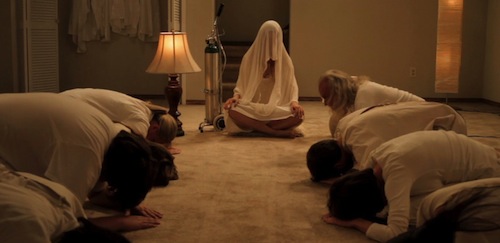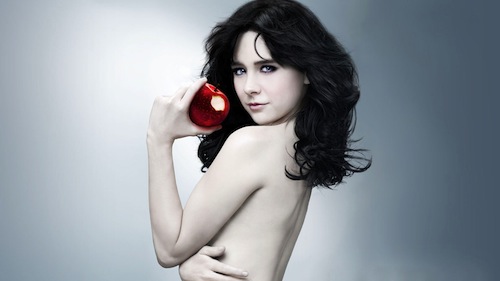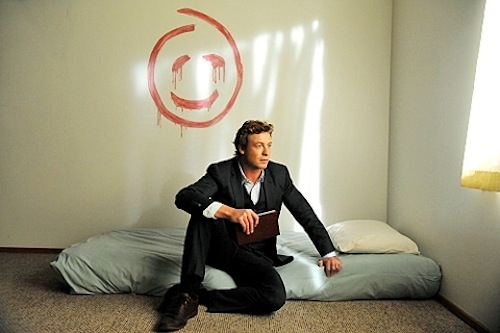The Ten Creepiest Fictional Cults of the 21st Century
 |
Every few years, a shift occurs and the media highlights new or different movements in popular culture. The war on terror and “say no to drugs” weren’t just used by politicians; they also seeped into our movies and television programs. We’re never exactly sure just how it happens, but right now we’re in a new age of cults. At least fictional ones.
Is there any correlation between a cultish figure and which party runs the White House? Who knows, but from the Clinton era came that one club with the first rule not to talk about it. Bioshock‘s citizens of Rapture (the ones with plasmids, anyway) might have been a comment on the Bush administration’s fondness for Ayn Rand’s objectivism philosophy. (The leader of the underwater dystopian city was named ‘Andrew Ryan.’) This year, the CW had a short-lived series literally titled Cult, but there are far more successful and interesting leaders to follow. We’re not entirely surprised to see so many made-up groups popping up during the Obama years.
Here’s my list of the creepiest, sometimes most seductive but purely fictional cults of the 21st century that I’ve experienced in films, TV, and videogames. Many of them are almost convincing enough to make me want to drink the Kool-Aid. Almost.
10. Living on the Compound, Martha Marcy May Marlene
What better place to start then a good old-fashioned, rurally isolated male-run cult? Elizabeth Olsen (Silent House) is Marcy May “a leader and a teacher” who’s just fled from an unincorporated barn run by charmer Patrick (John Hawkes) located in the Catskill Mountains. The story goes back in time to show how MM fell under Patrick’s spell while also zipping to the present where she’s reunited with her sister, Lucy (Sarah Paulson) who knows her as plain old ‘Martha.’ (The name Marlene is the one all the women on the compound use whenever answering an old rotary-dial phone.)
The hook of the story is the back and forth between M’s brainwashing and her struggle to leave all that behind. That we never think she really can leave it all behind is a testament to Olsen’s performance. She embodies M with a hint of arrogance that runs right below her timid smiles. What makes MMMM so compelling is how we’re almost always tethered solely to M’s point of view.
9. The Unitologists, Dead Space 3
 |
In EA’s third and final (?) installment of the survival horror series, butt-stomping engineer Isaac Clarke is out to stop the nutty worshippers of The Marker once and for all, in a distant future where planet-cracking for resources is the norm. Unitologists are essentially, earth-born folks that believe mankind’s time has reached the end so… all hail the Nercomorphs! Oh, and the only way to kill a nasty Necromorph is by dismembering the limbs from the their scaly torsos.
At time of release, the original Dead Space felt like a sci-fi version of Bioshock, with the Church of Unitology’s leader Michael Altman a more sinister Andrew Ryan. Both games use plenty of clever propaganda ads (O Love My Peng!) as a way of satirizing popular culture.
Protagonist Clarke has always been stuck in the middle of this cultish storm, but this third outing is the first time we’re not just splicing monsters, but those wacky religious members too. Clarke’s sanity is always pushed to the brink – if only he would just give in to the Unitologist’s way of thinking!
The dread of Dead Space has always been the game’s creepy signature vibe. Trapped on a ship, usually alone (skip the lame co-op mode in DS3), this is as close as I ever want to get to being stuck on a spaceship like the Nostromo. Imagine if Burke actually worshiped those face-hugging xenomorphs!
8. The One, Caprica
 |
| Sexy Toaster… sign me up. |
The short-lived Battlestar Galatica spin-off did a great job of getting inside the terrorist cell known as The One; a religious order that dared to believe in a singular deity over many. (Hence, all those “thank the gods” references in BSG). At the heart of the story, is Zoe Graystone (Alessandra Torresani) a teen killed and then resurrected via a computer program written by her father, Daniel (Eric Stoltz). Eventually, her new self would be placed in a machine: the very first sentient toaster a.k.a. Cylon.
Another neat angle of the show was the virtual world that Zoe and her friends inhabited. If they needed to let off steam they jacked into a chaotic nightclub that promotes murder and sex with no consequences whatsoever.
Too often Caprica veered into lame teen love subplots, the kind of stuff better served on the CW than Syfy. Then again, watching the school’s principal Ms. Willow (Polly Walker) persuade her favorite students to sacrifice themselves for “the cause” freaked me out.
7. Keepers of the Kid, Paranormal Activity
 |
How quaint a regular old pentagram looks nowadays…
Who knew a demon named Toby would create such a fuss? Over the span of four films we’re really no closer to knowing much of anything about these child-abducting weirdos, but they seem out of their mind. And has anyone else noticed that their strange symbol feels reminiscent of the ill-thought-out Samhainian mark that Michael was branded with in Halloween: V: The Revenge of Michael Myers?
PN3 made best use of the cultish plot, expanding it to a witches coven-like group, which makes sense since the heart of the series is about the relationship between the two sisters. Part 3 proves once and for all that the lonely sibling with the imaginary friend should never be left alone because she is in fact, never really alone.
6. The Cult of Killers, The Following
Kevin Bacon plays former FBI agent Ryan Hardy, who’s brought in to deal with his biggest capture: notorious serial killer Joe Carroll (Rome‘s James Purefoy), who was convicted of killing fourteen women. At the start of the season, Carroll is locked up like Hannibal Lecter with his followers on the loose to continue with his killing ways. Following is part Charles Manson, part Hannibal with the works of Edgar Allen Poe as a stand-in for the seven deadly sins in Se7en.
About halfway through the first season (mild spoiler) Carroll escapes, and demonstrates that he’s the classic “those who can’t teach” bad guy. He dreams of being the next Edgar Allen Poe but as a writer he’s a hack. As the season comes to a close we are privy to some of his prose. In a word: yikes. On the other hand, Purefoy plays up the fiendish to eleven, so Joe may be a mediocre writer but he is one heck of a cult leader. In flashbacks, we witness how he did some of his best recruiting while detained in a maximum-security prison. These scenes are crucial since the actual followers are way less compelling when Joe is not in the room with them.
Throughout the season the followers were too invested with being kidnappers, rather than engaging in the Jigsaw-like murder sprees the commercials teased. Thankfully, the last three episodes ratcheted up the crazy with the Cult of Killers hiding in plain sight right before striking an innocent with sharp objects.
No surprise: the best exchanges are between Ryan and Joe. The show’s highlight came in “The Curse” (episode 13) where the two are face-to-face. “Why are you surrounded by death? Death fuels me.” taunts Joe. “Me too,” says Ryan. Without revealing too much I will say the last episode works as a satisfying season one conclusion with a wicked cliffhanger piercing the final moments.
5. The cult of Apple: Hello South Park!
Satirists Matt and Trey take a bite into that juicy apple of technology when one day, Kyle hits “I agree” on one of those numerous updates without even giving it a second thought. (Like the rest of us.) Thusly, he becomes part of a group he didn’t even want to be in. Is that how we all became iPhone users? Just don’t end up being the middle piece on a HUMANCENTiPAD. Of course, that’s also the title of the premiere episode of season 15.
4. The Chosen of Red John, The Mentalist
 |
Yes, the CBS hit is a total procedural, but CBI consultant Patrick Jane’s (Simon Baker) obsession with serial killer Red John has captivated viewers with the show’s best episodes. Thought to have a list of at least 28 victims including Jane’s wife and daughter, RJ taunts Jane constantly. After five seasons (The Mentalist was into cults way before The Following), we’re still no closer to knowing his (or her?) real identity. The one constant is that every RJ crime scene is marked with a blood red, graffiti-style smiley face.
The current promos tease that by this season’s end, we will be down to only seven suspects. Seven?! I can only think of three, while most fans have had their eye on Bret Stiles (Malcolm McDowell), who just happens to be the leader of the “legit” cult group Visualize Self-Realization Center. Along the way, Jane keeps running into RJ’s devotees. My favorite was Bradley Whitford, who at one point, I thought was Red John. This season, I dug Jane’s weird, but short-lived relationship with Lorelei Martins (Entourage‘s Emmanuelle Chriqui). Now it appears that Kevin Corrigan, who taught Agent Dunham to bowl in Fringe, and goes by the name Prof. Professorson on Community, might be Red John or at the very least part of RJ’s following. The search continues…
3. Citizens of Rapture/Columbia, Bioshock/Bioshock Infinite
“I chose something different. I chose the impossible. I chose… Rapture!” – Andrew Ryan
“The Lord forgives everything, but I’m just the prophet, so I don’t have to.” – Zachary Hale Comstock
Will there always be a lighthouse, always man and always a city? I don’t know, but this simple set-up worked wonderfully for Bioshock and Infinite. Two cities, one underwater, one above the clouds, both taking place in an alternate history of America.
The citizens of Rapture (the one below sea level) followed a man named Ryan who envisioned a place where the truly excellent could thrive. (Never mind all those underlings who need to keep the place clean and running.) The citizens of Columbia pretty much had their heads and everything else about them above the clouds as they followed Comstock, their “Prophet,” to live in buildings that float on giant balloons. Comstock seceded his metropolis from the pagans of the Union.
What makes both games’ cults so fascinating are the ways that the narrative compels the player (who arrive at their destinations by a lighthouse) to want to know not just how to beat the bad guys, but just how these utopian places could ever really work. The short answer: they don’t. Both games wisely keep our time with Comstock and Ryan limited, making their remarks and their spell all the more alluring.
2. The Cause, The Master
Check out this great scene that didn’t make the final cut.
“Would you care for some informal processing?” – Lancaster Dodd.
P.T. Anderson’s latest was much more than just a film about Scientology. Even Tom Cruise (who played self-help guru Frank T.J. Mackey in Magnolia) watched it. Set in Post-War America where several factions popped up – L. Ron’s is just the one that is still thriving – it focuses on Freddie Quell (mesmerizing Joaquin Phoenix), the rascal that can’t be tamed. Not even by “The Master” Lancaster Dodd (Phillip Seymour Hoffman, mesmerizing in a completely different way) who founded The Cause, a group devoted to separating man from his animal instincts. What’s most surprising, however, is the notion that the real dependent in any brainwashing organization is the leader, not the follower.
Like most great films, The Master gets better with repeat viewings. The first time I was more in awe of the great performances and the immersive 70mm photography than the story. On my second viewing, however, I found myself sympathizing with Dodd. (Quell remains a fascinating mystery to me.) Dodd maybe a fraud, an adulterer and a terrible drunk but his insistence on trying to make sense of the world through his own “making it up as I go along” vocation reveals him to be a sad mouse forever spinning on one of those wheels. By far, Dodd is the most human of all the cult leaders on this list.
1. Group 54, Sound of My Voice
Co-written and starring Brit Marling (Another Earth) the story follows two wannabe journalists, Peter and Lourna, who are out to expose a sect that obeys a woman who claims to be from the future. Dressed in white, speaking in soft, but harsh tones Maggie (Marling) presents herself as vulnerable yet dangerous. As the true purpose of Group 54 (Maggie claims to be from the year 2054) becomes known, skeptic Peter (Christopher Denham, who also stars in The Following) starts to let his guard down. Lourna (Nicole Vicius) does not. At a scant 85 min, the film and director Zal Batmanglij keeps a tight grip on viewers so as not to break Maggie’s stare. We rarely leave the basement, where the sermons are many, and the faithful find out about the future of society (who knew the Cranberries’ pop melodies would survive the apocalypse?)
There are a lot of good to great tales on this list, but Sound of My Voice is the most efficient and successful at luring the viewer into a state of complacency. It might be just because Marling is so darn attractive, but I seriously wanted to believe Maggie. Er, I mean, I DO believe her.
Hey, we all want followers, right? So follow us on Twitter @ToplessRobot! Let the Cult of TR begin…
